Demystifying the Difference between BW on HANA, BW, Edition for HANA & BW/4HANA
Category: SAP BW Posted:Apr 11, 2017 By: Ashley Morrison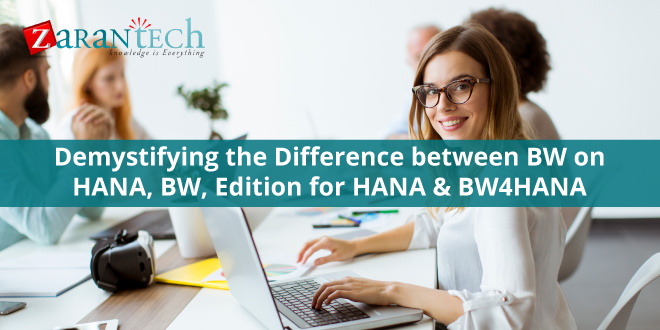 With the release of BW/4HANA, there has been a lot of unanswered queries and confusion with regard to the differences between:
With the release of BW/4HANA, there has been a lot of unanswered queries and confusion with regard to the differences between:
- BW on HANA
- BW, Edition for HANA
- BW/4HANA
Most organizations and individual users are still not sure and need a crystal clear understanding of such differences. To put things in perspective and to provide a clear and crisp answer to this question, we have to explore all the facets of all three aspects of HANA.
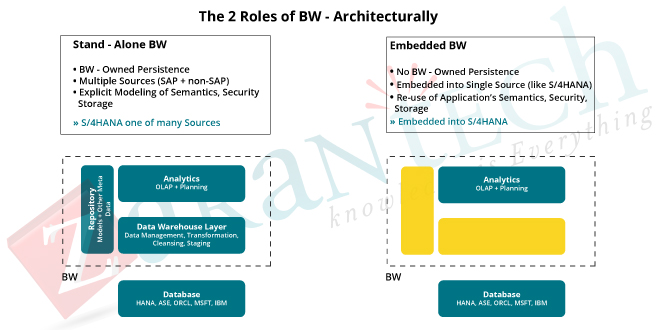
Modeling Differences:
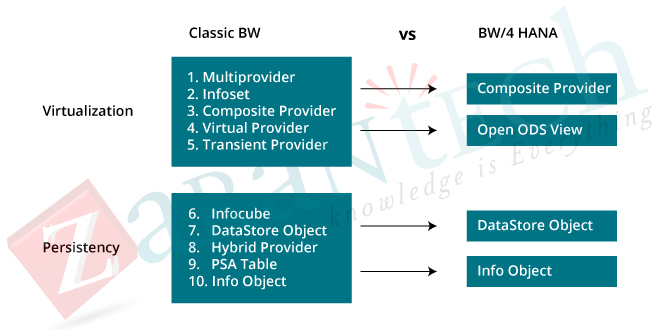 Consumers, who have been looking forward to the migration of SAP BW to HANA, rejoiced as per 7 September 2016, as SAP BW on HANA was officially succeeded by BW/4HANA 1.0 setting aside concerns that BW would be no more because of HANA. When it comes to functionality, BW/4HANA is quite similar to BW7.5 SP4. However, SAP is bent on stating that it is a fresh product, mainly for legal reasons. But as a consumer, it is best to assess the effect it bears on your existing SAP strategy and growth projections.
Consumers, who have been looking forward to the migration of SAP BW to HANA, rejoiced as per 7 September 2016, as SAP BW on HANA was officially succeeded by BW/4HANA 1.0 setting aside concerns that BW would be no more because of HANA. When it comes to functionality, BW/4HANA is quite similar to BW7.5 SP4. However, SAP is bent on stating that it is a fresh product, mainly for legal reasons. But as a consumer, it is best to assess the effect it bears on your existing SAP strategy and growth projections.
Looking at the new BW/4HANA product
Many simplifications are implemented in the product but the 4Q16 delivered Business Content of SAP BW/4HANA Content Add-On 1.0 is similar to the delivered SAP HANA-optimized BI Content of BI CONT 7.57.
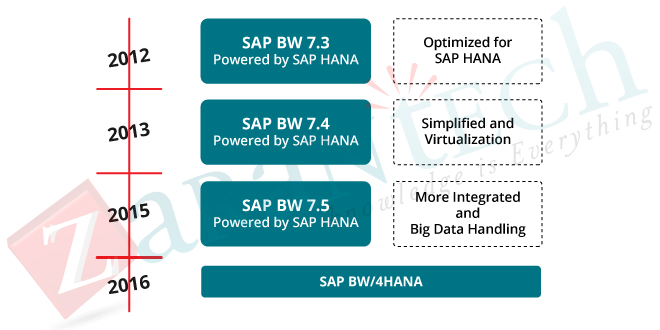
The list of planned innovations is highly intriguing at the very least. SAP has made BW accessible as a source system type for Hadoop utilizing Apache Spark, and organizational Big Data and Machine Learning initiatives may profit from this. It is an in-memory data processing framework which is open-source. The second quarter of 2017 will see SAP BW/4HANA Analysis Process being executed based on Spark/Hadoop.
SAP is really progressive here with the enterprise adoption of Spark which is still really early, according to the Gartner Hype Cycle for Data Science, 2016. Spark is being integrated with other cloud offerings such as Ariba and SuccessFactors in the future.
Changes effected in BW/4HANA in data modeling, reporting, and analytics
While traditional BI Content is not supported any longer (software elements such as BI_CONT and BI_CONT_XT), extractors such as Business Content DataSources – that are released for Operational Data Provisioning (ODP) will continue to be supported. The ODP Source System is displacing the SAP Source System in SAP BW/4HANA. Analytics are now built on top of HANA-optimized objects. An example for this is the advanced DataStore Objects (DSO) along with CompositeProviders and no longer on InfoCubes and Classic DSO’s.
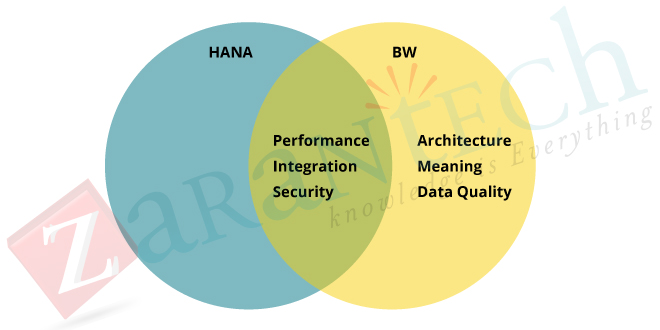
SAP BusinessObjects Analysis, SAP BusinessObjects Cloud, and SAP BusinessObjects Design Studio are all front-end offerings from SAP. SAP Business Explorer (BEx) is not supported anymore. Open interfaces are offered by SAP BW/4HANA for third party BI tools which are based on OData, SQL, and MDX.
Next-step options
Organizations will need to convert their object set again if they are shifting to BW/4HANA which is almost semi-automatic. This is great for clients who decide to upgrade instead of starting afresh
They’ve decided to keep ERP ‘s like S/4HANA in-house there’s more good news. This means BW/4HANA will be available as an on-premise version, adjacent to cloud versions running in the SAP HANA Enterprise Cloud (HEC) and the AWS public cloud (which could be deployed in less than two weeks). It is worth noting that current BW on HANA will continue to be on the SAP product list for a while but innovations will mainly be performed in BW/4HANA.
Assessing the impact of BW/4HANA
BW/4HANA is a great replacement to SAP BW on HANA. If not already in progress, it is best for organizations to review your internal SAP strategy and roadmap ASAP. Essential things to consider are any current BW on HANA initiatives organizations have currently running, reporting toolset policies, sourcing from a cloud. This, coupled with the effect upon add-ons like SEM-BCS and BPC, will affect planned or just-in-time MDM- initiatives and Big Data, along with user experience.
The latest statistics by SAP show that almost 14-15K consumers are using their BW data warehouse with a third party database such as Oracle, Microsoft SQL Server, IMB DB2 and more. Organizations have the HANA DB as a background with the release of BW 7.5 and most users are thinking on how exactly to implement this, will have to consider the impact on their current data warehouse.
Existing BW customers (up to 7.3) might have several questions. Given below are some of the commonly asked questions.
- What are the advantages of the upgrade?
- The relevance of a plan to upgrade ECC to Suite on HANA (SOH) or S/4?
- Is there any role for SAP BW if S/4 Hana is the source system?
- If a new Data warehouse is being used, should SAP BW 7.5 be considered?
BW handles non-cumulative data for stock, complex hierarchies, SAP security and authorizations, and several functionalities. Along with this, there is a new modeling technique for HANA called LSA++, which simplifies and speeds up the construct and operations of an EDW.
The future of data warehousing at SAP and the role of BW are as follows:
1. Simplified Data Models
- SAP BW 7.4 simplifies data modeling by unifying InfoProviders.
- New architectures should regard SAP BW and SAP HANA as a modeling environment for detailed implementations.
- Open ODS View, CompositeProviders and DataStore object are new objects which have Eclipse-based modeling available for themselves.
- The architecture benefits here greatly from the added flexibility given by New InfoProvider, for instance, InfoProviders joins with CompositeProvider
2. Leveraging the power of SAP BW and SAP HANA
- Open ODS Views permits easy consumption of external data.
- Unification of Open ODS Views with External Data Structures.
- Field based modeling can be used to construct lightweight models without the necessity of creating InfoObjects. Agile model creation and rapid prototyping are greatly benefitted by this.
3. SAP HANA Smart Data Access for SAP BW
With Smart Data Access (SDA), users can directly read smaller data volumes in CompositeProviders or HANA modeling views without ever persisting it in native HANA or SAP BW. This functionality enables your SAP BW on HANA to become a federated data warehouse. Thus removing the need to persist all data directly in HANA
Smart Data Access:
- Makes Big Data scenarios possible such as consolidation of Hadoop with enterprise data in SAP BW
- Automatically handles Deltas
- Integration of SAP BW data with federated data models is made possible
4. Real-Time Replication with SAP LT Replication Server
- Replication of data in real time into SAP BW is made possible through the ODQ framework
- SLT can be utilized in two modes either scheduled or real-time
- Various subscribers can conveniently share the same delta information
- ODQ permits data transfer into InfoProvider directly, and PSA can be skipped
5. Efficient Data Management with Dynamic Tiering
- SAP HANA Dynamic Tiering makes main memory resource management optimization a reality by taking advantage of extended tables. For extended tables to be set, PSA and Advanced DataStore objects can be used warm data is then shifted from the Main memory to the extended tables.
- This minimizes the consumption of main memory as warm data is stored in disk-based storage
- Usage depends on the object purpose. For instance, staging layer objects with infrequent reporting activities but still in focus for data operations are great candidates for warm data
Conclusion
In order to create an app, data mart, data platform or database, native HANA can be utilized on its own. To construct an Enterprise Data Warehouse, the BW on HANA route comes highly recommended.
Therefore, we have SAP BW as an application-driven approach with the release of BW 7.5. And there is also an SQL-based approach just with SAP HANA, without other applications such as BW atop it. The SAP HANA and SAP BW integration enable organizations to simplify the data modeling processes, optimize the agility of the Enterprise Data Warehouse (EDW) and minimize the cumbersome nature of the EDW landscape.
With the broad use of Big Data at enterprises, it is becoming increasingly clear that BW will play a crucial role in the overall HANA data warehouse, while consolidating data from a multitude of sources like S/4, other ERPs, Hadoop, and more.
If you are planning to boost your skills, choose our best online training platform, and learn from industry experts. So what are you waiting for? Visit ZaranTech, to skyrocket your career with the unique learning needs because Learning Never Exhausts The Mind.

 99999999 (Toll Free)
99999999 (Toll Free)  +91 9999999
+91 9999999